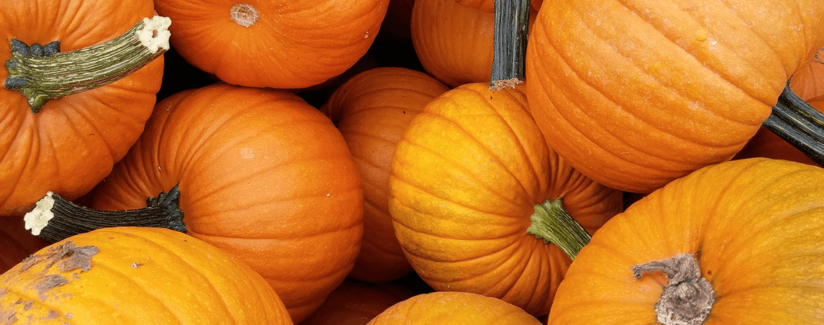
Pumpkin Spice: Everything Nice (And Not So Nice) About It
10/24/2016
Pumpkin spice season is upon us. This cozy flavor combination is a fall favorite that grows more widespread each year.
For the full picture of flavor and nutrition, Dr. Julie Garden-Robinson, professor and Extension specialist in nutrition and food safety at North Dakota State University, gave us great insight about what’s nice and not so nice about pumpkin spice.
First, the good news is there is good reason to enjoy pumpkin spice! Dr. Garden-Robinson explains that pumpkins are packed with nutrients, especially beta-carotene and fiber.
“Our bodies use beta-carotene to produce vitamin A. In fact, one-half cup of pumpkin provides 200 percent of the current recommendation for vitamin A, along with lutein and zeaxanthin, which are pigments that promote eye health,” she said. “Pumpkins are also rich in potassium, which helps our muscles contract and nerves fire.”
Pumpkin is naturally low in calories, she added. One-half cup of mashed pumpkin has just 24 calories, no fat and six grams of carbohydrates.
An aromatic blend of cinnamon, nutmeg, ground ginger, allspice and cloves is what makes pumpkin spice special. More good news here. Spices deliver flavor with only negligible calories – one teaspoon of cinnamon has just six calories – and they come with an added bonus.
“Some spices are rich in antioxidants, which may have some health benefits. For example, some researchers have studied the effects of cinnamon on blood sugar levels and cholesterol levels, with promising results,” Dr. Garden-Robinson said. “Cinnamon and nutmeg enhance the natural sweetness in foods, or at least distract your taste buds from wanting a caloric sweetener. Some people find that adding a little cinnamon to their coffee may push back a craving for a sweet treat.
Latte alert
The “grande dame” of autumn indulgences is the pumpkin spice latte. This rich coffee drink is best enjoyed as a rare treat. “A warm pumpkin spice latte certainly tastes great, but we need to remain aware of the amount of calories, fat and sugar we are consuming as we sip our tasty autumn beverages,” Dr. Garden-Robinson says.
Starbucks reports that a 16-ounce serving of pumpkin spice latte has 380 calories, 14 grams of fat (including 8 grams of saturated fat) and 52 grams of carbohydrate (including 50 grams of various sugars). There are some ways to ease the calorie count. “Opt for fat-free milk in your latte to reduce calories, or order the smallest size or share your latte. You might also go on an extended hike to enjoy the fall leaves after enjoying a regular pumpkin latte. Theoretically, just 100 extra calories per day can add 10 pounds to your frame in a year,” she said.
This time of year, many of our favorites like pumpkin pie and pumpkin cookies can also be high in sugar. The nutritionist advises keeping track of that added sugar in sweets. The Dietary Guidelines for Americans recommends no more than 12 teaspoons of added sugar, but on average we consume 22 teaspoons of sugar per day.
But that doesn’t mean you have to watch pumpkin spice season from the sidelines.
“What’s a person with a sweet tooth and a hankering for pumpkin to do? Cut the pumpkin bars, muffins and slices of pie into smaller pieces. Try novel ways to enjoy pumpkin, such as parfaits or pumpkin dip. Enjoy the pumpkin-flavored dips with fresh apples and naturally sweet fruits,” she advises.
Other great ways to get the nutritious benefits of pumpkin:
- Pumpkin soup
- Pumpkin hummus
- Add some pumpkin puree to pasta sauce or chili
- Sweeten pumpkin with some honey and layer with a pumpkin parfait by layering yogurt with honey-sweetened pumpkin
- Use pumpkin to substitute for part of the fat in baked goods such as brownies
DIY pumpkin spice
Both canned and fresh pumpkin are very nutritious, Dr. Garden-Robinson advises. Canned pumpkin offers one-step convenience, but if you want to make your own, choose the small, rounded varieties known as sugar pumpkins. They have a better texture for cooking than the big ones that are best for jack o’lanterns.
“Fresh pumpkin can be used in the same way you would use canned pumpkin. Freshly cooked pumpkin often will have a lighter color and a texture more like sweet potatoes. Canned pumpkin usually has a stronger pumpkin flavor and results in a pie with a firmer, smoother texture. Pumpkin is pulverized before commercial canning to give it a uniformly smooth texture,” Dr. Garden-Robinson said. “To make your own fresh pumpkin, simply rinse the pumpkin with water and scrub with a vegetable brush, then remove the stem and cut the pumpkin in half. Scoop out the seeds and stringy parts. Spray a baking sheet with nonstick cooking spray, and lay the pumpkin flat side down on the baking sheet. Bake for about an hour, scoop out and mash or puree in a food processor.”
If you have extra cooked or canned pumpkin, it can be frozen for later use. She suggests freezing it in an ice cube try, then add a cube or two to chili, oatmeal or smoothies.
“Pumpkin seeds are nutritious, too. Try roasting pumpkin seeds by tossing them in a small amount of salad oil and adding your spice of choice, such as cumin, chili powder, cinnamon or your favorite spice. Store in a sealed container in a cool place,” she said. You can also mix up your blend of pumpkin spices and use it to flavor dishes.
Pumpkin spice is a delicious part of the fall season. Share with us your favorite ways to savor the flavors and enjoy its healthy benefits.


























